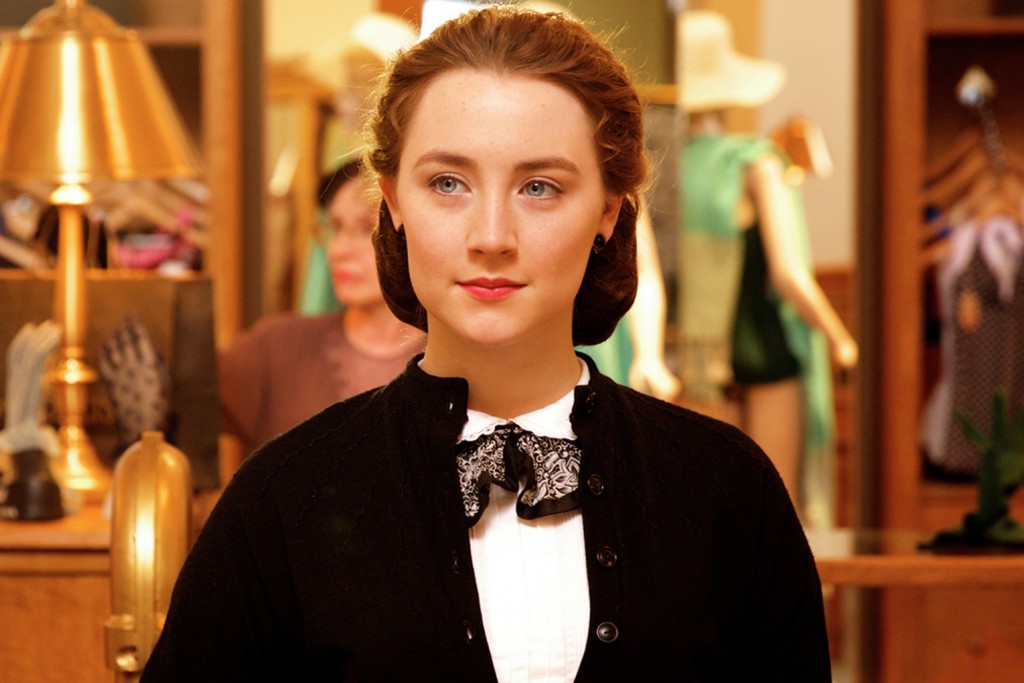This guest post is written by Fernanda Cunha. | Spoilers ahead.
I watched Brooklyn in the same week my Facebook newsfeed flooded with reports of U.S. Immigration and Customs Enforcement (ICE) raids across the country. In December, I had both heard and read of the Department of Homeland Security’s plan to raid and deport Central American families, at the same time, the John Crowley-directed film Brooklyn continued playing to rave reviews. As a first generation immigrant whose main self-identifier is native of Brazil / immigrant / foreigner, I deliberately and adamantly seek stories about the immigrant and diasporic experience, and I’m excited when they manage to permeate mainstream culture and media. In some ways, this was also true for Brooklyn — though my excitement was not the same as discovering Chimamanda Ngozi Adichie’s novel Americanah or Cristina Henríquez’s The Book of Unknown Americans, both contemporary novels about different immigrant experiences — as I looked forward to watching a young woman’s migrant journey. In retrospect, having now seen the film, I am not entirely sure how I ever thought I would relate to the film’s premise. In its desperate attempt to tell a universal story (which is unsurprisingly white and Western), the film only ends up feeling false, and ultimately falls short.
Released to select theaters in November 2015, the recently Academy Award-nominated Brooklyn (based on the novel by Colm Tóibín) stars Saoirse Ronan as Eilis Lacey, who migrates from Ireland to Brooklyn in the 1950s, the story begins with a hesitant, and nervous Eilis preparing for, and somewhat dreading, her journey to the United States, and ends with her triumphant Brooklyn “homecoming,” after returning to her original hometown of Enniscorthy and feeling trapped by her surroundings and her sister’s sudden death.
Visually, the film delivers — the cinematography looks pretty, and the production and costume design both succeed in building a believable 1950s visual story. It’s in Ronan, however, that the film finds its backbone. Her performance makes what could potentially be unrealistic and false scenes feel sincere and raw. The film’s idealistically brief moments of homesickness and grieving become the most touching scenes of the film through Ronan’s physical translation of a weak and lacking screenplay. And lacking it is. Eilis’s experiences as an immigrant take a backseat in her newfound love for an Italian-American man, and the immigrant’s story I was so looking forward to is lost in the film’s attempt at Western appeal and universality. From the thousands of immigrant stories that could have been told, that Hollywood chose a heterosexual love story between two white Westerners in the 1950s is telling — that critics and audiences have lauded and lavished it with praise is even more so.
Besides Eilis’s laughably brief moment of homesickness and her inability to be home for her sister’s burial, none of her experiences as an immigrant felt familiar to me. She does not get made fun of for her accent — she does not even have to struggle with learning English, and in turn does not have to spend most of the next two years in the United States in silence, embarrassed of the ways her tongue cannot seem to master the language. She relates to Americans easily, and there are no mentions of deportation. Despite a small disappointment at not seeing myself reflected on screen, I am okay with this unfamiliarity. I am sure hers looks like another immigrant’s story, and I understand that the immigrant experience is not monolithic and manifests differently for every individual.
I struggle, however, with Hollywood’s choice to tell and so openly embrace this kind of immigrant’s story while the United States continues to deport Central American immigrants to mostly widespread silence. I worry about the continued invisibility of native Latin American peoples in the United States, especially undocumented ones, when their dehumanization persists through a proliferation of Latin American xenophobia and hate speeches of public figures like Donald Trump. Representation is meaningful and powerful, and the lack thereof is just as salient. I wonder what it means for others to not see these representations, to be so sheltered to stories of undocumented immigrants that society perceives their actions and existence as inherently and automatically criminal.
In today’s social and pop culture climate, it’s not difficult to wonder how differently critics and audiences would receive a film like this if told from a Latin American woman’s perspective. It probably would have never been made. In the miraculous chance that it had, I wonder if audiences would have viewed Eilis’s decision of accepting an opportunity in the United States as stealing, taking something that was not hers. I doubt Eilis’s actions of marrying an American before returning to her home country where she rekindles a friendship with another man and flirts with the idea of staying would have been well received. Audiences would have no sympathy for a woman like that. I can imagine the kinds of names she would have been called, and the implications others would discern in her actions.
In some ways, I am glad this story doesn’t exist, not only because I found the film uninteresting and lazy, but because it would be a disservice to the kinds of stories I experienced and heard as an immigrant. Still, the disappointingly simplistic story Brooklyn tells beats the reality of not having our stories told at all. I would rather see a simple and two-dimensional love story between a Latina immigrant and an American man than watch another movie set in Latin America in which crimes and violence dominate, and all perpetuated by the Latin@ characters. Stories in which the American characters suffer tremendously in a ruthless foreign land — the creative voices behind those films receive praise endlessly for their bravery, and the Latin@ voices continue to be ignored and silenced.
Fernanda Cunha is a native of Brazil living in the U.S., a writer, and a student of Women’s Gender and Sexuality Studies. Her writing focuses on the humanization of immigrants, often done through a feminist lens. Her writing has been featured in The Feminist Wire.













